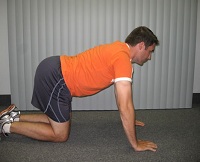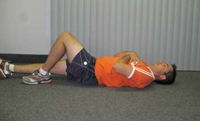As human function and performance experts we realize that accidents can be prevented both by implementing a sound ergonomics program including both engineer and administrative controls. One of the best administrative controls is exercise. The benefits of exercise are extensive, one of which is building and maintaining healthy muscles, bones and joints. In the world of exercise or fitness a common phrase used is 'core function', 'core strengthening' and 'core stability'. The premise behind these exercises is developing strength around the lower back to prevent injuries
Instability
can cause "buckling" in the spine when we perform seemingly simple
tasks such as bending over to pick something up. Research has
identified the deep muscle running along the vertebrae (spine) have
decreased activation causing the spine to "buckle". Therefore, the
muscles need to be trained to stiffen to prevent buckling. By training
these muscles to stiffen when we engage in strenuous or every day
activities we will produce joint stability in the lower back and prevent
tissue irritation and injury.
Dr.
S. McGill, who is a leading researcher and biomechanist from the
University of Waterloo, suggests the most beneficial training for the
spine involves muscle endurance rather than strength training performed
with a neutral spine posture. From McGill's research, he suggests the
following exercises to develop a stable spine.
Cat-Camel Warm Up
This
is a flexion-extension exercise to create joint mobility but is not
intended as a stretch. You simple increase the curve in the lower back
by pushing your stomach towards the floor (camel) and then increase the
curve in your upper back by pushing your mid back towards the ceiling.
This is not held, just move up and down though the range of back
flexion and extension. Perform 6 cycles.
| Step 1 |
Step 2 |
 |
 |
Side Bridging (for Quadratus Lumborum)
Not
trying to get to anatomical, but this muscle is responsible for lower
spine stability on the sides (most of us know this area as the love
handles). McGill proposes more emphasis should be placed on this type
of exercise than the back extensors.
This
can be done with the knees bent or straight. These exercises are
isometric, which means there is no movement as the muscle is
contracted. The contraction is held for 3-10 seconds and repeated up to
5 times per side. If you have shoulder problems, the hand does not have
to remain on the hip but can be placed on the shoulder to provide some
additional support. The advanced stages of this involve rotating onto
the forearms while maintaining a neutral spine.
Bird Dog/Superman
Some
caution is warranted when performing this exercise and may not be the
most suitable for those who are experiencing low back pain. It is
advised that medical clearance be obtained before attempting this
exercise.
As with all
of the exercises, the focus is neutral spine while activating the
muscle group. The exercise should be held 3-10 seconds and repeated
three times. It is important not to twist the spine but lift the leg
with both hips parallel to the floor. It is easier if you do it in
front of a mirror or have someone watch you. You lift the opposite arm
and leg. The higher you lift the arm the more upper back muscle
activation. When you bring the leg and arm down, you do not touch the
floor but simple sweep bringing the hand and knee together and moving
it back up. Do the same on with the other arm and leg.
Abdominal Bracing
Sit-ups
are a "no, no" these days. Enough research has been conducted to
clearly show that there is no benefit to doing full sit ups and in
fact, are probably more detrimental than beneficial to lower spine
health. Unfortunately one exercise cannot sufficiently challenge all of
the muscle groups of the abdomen. Therefore, several versions of the
curl-ups are recommended by Dr. McGill.
We
illustrate one type of curl-up or abdominal brace. One leg is bent, the
other remains relaxed. The hands are placed anywhere but behind the
head. The reason we do not recommend placing the hands behind the head
is because you will tend to pull the head up with the hands causing
increased neck flexion. Fix your eyes on a spot on the ceiling directly
above you. Tighten your stomach. The best way we can describe this is
to contract the lower abdominal muscle as if you didn't want to pass
gas (I know, nice thought). Hold the contraction and lift your shoulder
blades off the floor while maintaining your focus on the spot on the
ceiling. Hold for 3-10 seconds and repeat three times. Switch leg
positions, placing one down and the other up and repeat.
| Step 1 |
Step 2 |
 |
 |